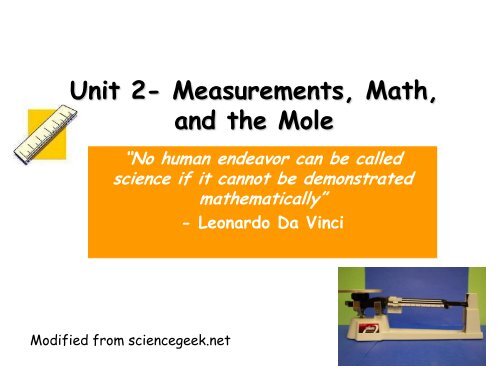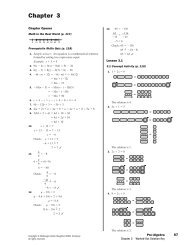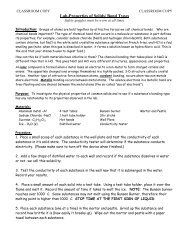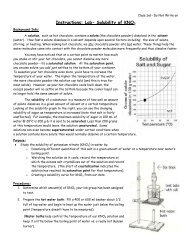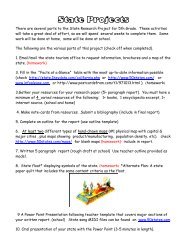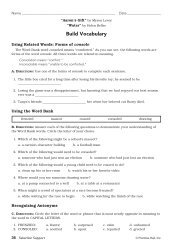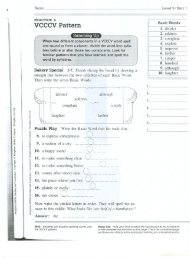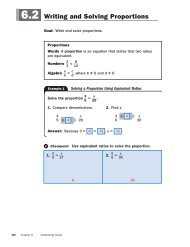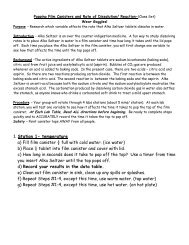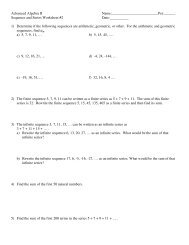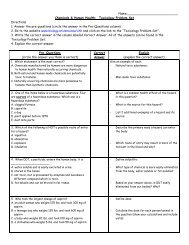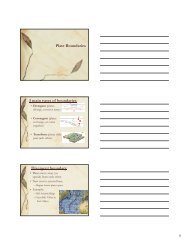Unit 2- Measurements, Math, and the Mole
Unit 2- Measurements, Math, and the Mole
Unit 2- Measurements, Math, and the Mole
You also want an ePaper? Increase the reach of your titles
YUMPU automatically turns print PDFs into web optimized ePapers that Google loves.
<strong>Unit</strong> 2- <strong>Measurements</strong>, <strong>Math</strong>,<br />
<strong>and</strong> <strong>the</strong> <strong>Mole</strong><br />
“No human endeavor can be called<br />
science if it cannot be demonstrated<br />
ma<strong>the</strong>matically”<br />
- Leonardo Da Vinci<br />
Modified from sciencegeek.net
Nature of Measurement<br />
Measurement - quantitative observation<br />
consisting of 2 parts<br />
Part 1 - number<br />
Part 2 - scale (unit)<br />
Examples:<br />
20 grams<br />
6.63 x 10 -34 Joule seconds
Significant Figures
Measuring <strong>and</strong> Significant Figures<br />
Significant figures = indicate precision in a measurement.<br />
How to: record all digits in a measurement that are known<br />
with certainty on <strong>the</strong> device plus one final digit, which is<br />
an estimation.<br />
Ruler<br />
<strong>Unit</strong>s are in Centimeters (<strong>the</strong> arrow is <strong>the</strong> end of <strong>the</strong> object)<br />
2.83 cm<br />
Known (because of markings on<br />
<strong>the</strong> ruler)<br />
Estimated (you must include)
Ex. 1<br />
Practice- What are <strong>the</strong> best<br />
measurements?<br />
Ex. 2<br />
6<br />
a. 3 cm<br />
b. 3.0 cm<br />
c. 3.00 cm<br />
Answer: 3.0 cm<br />
a. 5.29 mL<br />
b. 5.290 mL<br />
5<br />
Answer: 5.29 mL
Thermometer<br />
Measuring Practice<br />
graduated cylinder<br />
Answer: 21.7 °C<br />
Answer: 30.0 mL
Rules for identifying Significant<br />
Figures<br />
#1= Non-zero integers always count<br />
as significant figures.<br />
ex: 3456 has 4 sig figs<br />
ex: 300<br />
has 1 sig fig<br />
Zeros (placeholders vs. Accuracy)<br />
#2 =s<strong>and</strong>wiched zeros always count as<br />
significant figures.<br />
ex: 16.07 has 4 sig figs.
Rules for Counting Significant<br />
Zeros<br />
Figures - Details<br />
#3- Leading zeros NEVER count as<br />
significant figures (<strong>the</strong>y are<br />
placeholders).<br />
Ex:<br />
0.0486 has 3 sig figs.
Rules for Counting Significant<br />
Figures - Details<br />
Zeros<br />
#4= Trailing zeros are significant<br />
only if <strong>the</strong> number contains a<br />
decimal point.<br />
Ex: 9.300 has 4 sig figs.<br />
Ex: 2000 has 1 sig fig (no decimal)<br />
Ex: 2000. has 4 sig figs (decimal)<br />
Ex: 0.02020 has 4 sig figs (decimal)
Sig Fig Practice #1<br />
How many significant figures in each of <strong>the</strong> following?<br />
1.0070 m 5 sig figs<br />
17.00 kg 4 sig figs<br />
100,890 L 5 sig figs<br />
3.29 x 10 3 s 3 sig figs<br />
0.0054 cm 2 sig figs<br />
320 cm 2 sig figs
Multiplying & Dividing with Sig Figs<br />
Multiplication <strong>and</strong> Division: # sig figs in <strong>the</strong><br />
result equals <strong>the</strong> number in <strong>the</strong> least precise<br />
measurement used in <strong>the</strong> calculation.<br />
Ex: 6.38 x 2.0 =<br />
12.76 13 (2 sig figs)<br />
Ex 2: 570 ÷ 2.5 =<br />
228 230 (2 sig Figs)
Sig Fig Practice #2<br />
Calculation Calculator says: Answer<br />
3.24 m x 7.0 m 22.68 m 2 23 m 2<br />
100.0 g ÷ 23.7 cm 3 4.219409283 g/cm 3 4.22 g/cm 3<br />
0.02 cm x 2.371 cm 0.04742 cm 2 0.05 cm 2<br />
710 m ÷ 3.0 s 236.6666667 m/s 240 m/s<br />
1818.2 lb x 3.23 ft 5872.786 lb·ft 5870 lb·ft<br />
1.030 g ÷ 2.87 mL 0.35888 g/mL 0.359 g/mL
Adding <strong>and</strong> Subtracting with Sig<br />
Figs (fyi only…don’t need to know)<br />
Addition <strong>and</strong> Subtraction: The number<br />
of decimal places in <strong>the</strong> result equals <strong>the</strong><br />
number of decimal places in <strong>the</strong> least<br />
precise measurement.<br />
6.8 + 11.934 =<br />
18.734 18.7 (3 sig figs)
Metrics
Commonly Used (SI) Metric <strong>Unit</strong>s<br />
Quantity Name Abbreviation<br />
Mass Gram g<br />
Length meter m<br />
Temperature Kelvin or Celsius K or °C<br />
Volume Liters or centimeter 3 L or cm 3<br />
Density Grams per centimeter 3 g/ cm 3<br />
Amount of<br />
Substance<br />
mole<br />
mol<br />
3 countries don’t use metrics: Burma,<br />
Liberia, <strong>and</strong> <strong>the</strong> USA
A List of <strong>the</strong> Metric Prefixes<br />
Multiplier<br />
Prefix Symbol Numerical Exponential<br />
yotta Y 1,000,000,000,000,000,000,000,000 10 24<br />
zetta Z 1,000,000,000,000,000,000,000 10 21<br />
exa E 1,000,000,000,000,000,000 10 18<br />
peta P 1,000,000,000,000,000 10 15<br />
tera T 1,000,000,000,000 10 12<br />
giga G 1,000,000,000 10 9<br />
mega M 1,000,000 10 6<br />
kilo k 1,000 10 3<br />
hecto h 100 10 2<br />
deca da 10 10 1<br />
no prefix means:<br />
deci d 0.1 10¯1<br />
centi c 0.01 10¯2<br />
milli m 0.001 10¯3<br />
micro µ 0.000001 10¯6<br />
nano n 0.000000001 10¯9<br />
pico p 0.000000000001 10¯12<br />
femto f 0.000000000000001 10¯15<br />
atto a 0.000000000000000001 10¯18<br />
zepto z 0.000000000000000000001 10¯21<br />
yocto y 0.000000000000000000000001 10¯24
Scientific Notation
Scientific Notation… why??<br />
In science, we deal with some very<br />
LARGE numbers:<br />
1 mole = 602000000000000000000000<br />
In science, we deal with some very<br />
SMALL numbers:<br />
Mass of an electron =<br />
0.000000000000000000000000000000091 kg
Imagine <strong>the</strong> difficulty of calculating<br />
<strong>the</strong> mass of 1 mole of electrons!<br />
0.000000000000000000000000000000091 kg<br />
x 602000000000000000000000<br />
???????????????????????????????????
How to Write in Scientific Notation<br />
A method of representing very large or<br />
very small numbers in <strong>the</strong> form:<br />
M x 10 n<br />
‣M is a number between 1 <strong>and</strong> 10 (can<br />
be a decimal too)<br />
‣ n is an integer<br />
Ex: 6.3 x 10 3
2 500 000 000<br />
9<br />
8<br />
7<br />
.<br />
Step #1: Insert an understood decimal point<br />
Step #2: Decide where <strong>the</strong> decimal must end<br />
up so that one number is to its left<br />
Step #3: Count how many places you bounce<br />
<strong>the</strong> decimal point<br />
Step #4: Re-write in <strong>the</strong> form M x 10 n<br />
6<br />
5<br />
4<br />
3<br />
2<br />
1
2.5 x 10 9<br />
The exponent is <strong>the</strong><br />
number of places we<br />
moved <strong>the</strong> decimal.
0.0000579<br />
1 2 3 4 5<br />
Step #2: Decide where <strong>the</strong> decimal must end<br />
up so that one number is to its left<br />
Step #3: Count how many places you bounce<br />
<strong>the</strong> decimal point<br />
Step #4: Re-write in <strong>the</strong> form M x 10 n
5.79 x 10 -5<br />
The exponent is negative<br />
because <strong>the</strong> number we<br />
started with was less<br />
than 1.
Practice: Convert <strong>the</strong> following<br />
into or out of scientific notation.<br />
1. 6, 000, 000, 000<br />
2. 0. 000 000 006<br />
3. 6 x 10 8<br />
4. 5, 234, 000<br />
5. 0. 00120<br />
6. 7.49 x 10 - 4<br />
7. 80, 080, 100,<br />
000<br />
1. 6 x 10 9<br />
2. 6 x 10 - 9<br />
3. 600, 000, 000<br />
4. 5.234 x 10 6<br />
5. 1.20 x 10 - 3<br />
6. 0.000749<br />
7. 8.00801 x 10 10
PERFORMING<br />
CALCULATIONS<br />
IN SCIENTIFIC<br />
NOTATION
Multiplying<br />
EX: (4 x 10 6 )<br />
X (3 x 10 5 )<br />
12 x 10 11<br />
Multiply <strong>the</strong> M factors<br />
toge<strong>the</strong>r <strong>and</strong> <strong>the</strong><br />
exponents are added<br />
toge<strong>the</strong>r.<br />
Change to correct Scientific<br />
notation format: 1.2 x 10 12<br />
Best answer with Sig Figs : 1 x 10 12
Practice Problem<br />
(8 x 10 6 m)<br />
X (3 x 10 4 m)<br />
Answer: 24 x 10 10 m 2<br />
correct.<br />
… but it’s not quite<br />
M must be a number between 1-10, right now<br />
it’s 24. So, you must make 24 into 2.4 <strong>and</strong><br />
move <strong>the</strong> decimal one more place.<br />
Best answer: 2.4 x 10 11 m 2
Dividing<br />
EX: (4 x 10 6 )<br />
÷ (2 x 10 5 )<br />
2 x 10 1<br />
Divide <strong>the</strong> M factors<br />
toge<strong>the</strong>r <strong>and</strong> <strong>the</strong> exponents<br />
are subtracted from each<br />
o<strong>the</strong>r.
Practice Problem<br />
(8 x 10 6 g)<br />
÷ (2 x 10 4 mL)<br />
4 x 10 2 g/mL
Ano<strong>the</strong>r way of seeing it written<br />
Multiply top <strong>and</strong> divide by bottom<br />
6 X 10 8 m x 2 x 10 3 m<br />
3 X 10 4 s<br />
= 12 X 10 11 m 2<br />
3 X 10 4 s = 4 x 10 7 m 2 / s
How to use your calculator with<br />
Scientific Notation<br />
1. Practice (6.0 x 10 5 ) x (4.0 x 10 3 ) on your<br />
calculator<br />
2. Punch <strong>the</strong> number (<strong>the</strong> digit number) into<br />
your calculator.<br />
3. Push <strong>the</strong> EE or EXP button. Do NOT type<br />
in x10 or use <strong>the</strong> 10 x buttons!!<br />
4. Enter <strong>the</strong> exponent number. Use <strong>the</strong> +/-<br />
button to change its sign.<br />
Answer= 2.4 x 10 9<br />
(some calculators will show this for <strong>the</strong> answer:<br />
2.4 9 -you have to know it is 2.4 x 10 9 )
Practice with Calculator<br />
(5.23 X10 6 )<br />
X (7.1 x 10 -2 )<br />
3.7133 x 10 5 , but<br />
3.7133 x 10 5 , but <strong>the</strong>re<br />
are 2 sig figs<br />
<strong>the</strong>re are 2 sig figs<br />
Best answer: 3.7 x 10 5
Adding <strong>and</strong> Subtracting with<br />
Scientific Notation<br />
(FYI ONLY… don’t really use Chem.)
(4 x 10 6 )<br />
+ (3 x 10 6 )<br />
7 x 10 6<br />
IF <strong>the</strong> exponents are<br />
<strong>the</strong> same, we simply<br />
add or subtract <strong>the</strong><br />
numbers in front <strong>and</strong><br />
bring <strong>the</strong> exponent<br />
down unchanged.
(4 x 10 6 )<br />
+ (3 x 10 5 )<br />
If <strong>the</strong> exponents<br />
are NOT <strong>the</strong><br />
same, we must<br />
move a decimal<br />
to make <strong>the</strong>m<br />
<strong>the</strong> same.
4.00 x 10 6<br />
+4.30<br />
.30 x 10 6<br />
YES!<br />
x 10 6
A Problem for you…<br />
Scientific Notation<br />
(2.37 x 10 -6 )<br />
+ (3.48 x 10 -4 )
Solution…<br />
0.0237 x 10 -4<br />
+ 3.48 x 10 -4<br />
3.5037 x 10 -4
Calculating Density
Mass = amount of matter<br />
something contains<br />
Weight Vs. Mass<br />
» Doesn’t change in outer<br />
space<br />
Weight = measurement of <strong>the</strong><br />
pull of gravity on an<br />
object.<br />
» Changes in outer space.
Density= Mass / Volume<br />
• How much “stuff” per unit<br />
volume<br />
•The density of a substance is unique <strong>and</strong> never<br />
changes regardless of it’s size or shape.<br />
Ex: Gold’s density = 19.3 g/ mL<br />
(same for <strong>the</strong> ring & gold bar)
• Is a physical property<br />
that is unique to each<br />
material<br />
• Can be used to identify<br />
a substance<br />
Density<br />
Density of ice= .92g/cm 3
Can find by:<br />
Volume- amount of space an object<br />
occupies<br />
1) Using a ruler<br />
• only if it’s a certain shape<br />
(ex: cube)<br />
• Measured in : cm 3<br />
2) Water displacement<br />
• Use for odd shaped objects<br />
• Measure in: mL<br />
*1 cm 3 = 1 mL (volume is <strong>the</strong><br />
same regardless of which<br />
way you measure it)
Ex: Muscle is more dense than fat<br />
Muscle density= 1.06 g/ml<br />
Fat density= 0.9 g/ml<br />
This is why<br />
people who<br />
start<br />
exercising<br />
don’t always<br />
lose weight,<br />
but clo<strong>the</strong>s<br />
fit<br />
differently
Dimensional Analysis
Sample Problems to Solve<br />
A) How many seconds has a 16 year old been<br />
alive?<br />
B) How many liters of water will Kate consume in<br />
1 year? Kate drinks 8 glasses of water in 1 day<br />
& 1 glass = 300 mL. There are 1000 mL in 1<br />
L.
The <strong>Math</strong> behind Dimensional Analysis<br />
6 zooms<br />
x<br />
4 zetas<br />
3 zooms<br />
=<br />
6 x 4 Zetas<br />
3<br />
=<br />
24 Zetas<br />
3<br />
= 8 Zetas<br />
•This is <strong>the</strong> level of math you will need to know in this unit.<br />
•You would cancel out everything on <strong>the</strong> top <strong>and</strong> bottom<br />
that are <strong>the</strong> same (including words).<br />
• In <strong>the</strong> end, multiply everything on <strong>the</strong> top <strong>and</strong> divide it by<br />
everything that has been multiplied on <strong>the</strong> bottom.
Dimensional Analysis<br />
• It is a method to solve conversion type problems<br />
• Uses Conversion Factors (relate 2 things to each o<strong>the</strong>r)<br />
• These are ei<strong>the</strong>r given to you or assumed to be known<br />
– Ex: 4 laps = 1 mile (<strong>the</strong>y are equal to each o<strong>the</strong>r)<br />
Can also be written as a fraction:<br />
4 Laps<br />
1 mile = Or 1 mile • Can be written in<br />
1<br />
4 laps ei<strong>the</strong>r direction<br />
When solving problems use this method:<br />
GIVEN X CONVERSION FACTOR = Find
Sample Dimensional Analysis Problem<br />
Ex: Convert 15 cm into meters<br />
Given x conversion factor = Find<br />
Ex: 15 cm x 1 meter =<br />
100 cm<br />
.15 meter
Dimensional Analysis<br />
Sample Problem #2<br />
•You're throwing a pizza party for 15 people.<br />
•each person might eat 4 slices.<br />
•each pizza will cost you $14.78<br />
•1 pizza will be cut into 12 slices.<br />
•How much is <strong>the</strong> pizza going to cost you?<br />
Starting x conversion factors<br />
= find<br />
15 people 4 slices 1 pizza 14.78 dollars<br />
1 person 12 slices 1 pizza<br />
=<br />
$73.90<br />
$ 74<br />
dollars
Good use of D.A. - performed by a<br />
senior planning a trip<br />
A group of friends are going to Disneyl<strong>and</strong> for<br />
graduation. Driver wants to know how much to<br />
charge his friends <strong>the</strong> trip to cover his gas costs?<br />
It’s 876.8 miles round trip.<br />
-Car gets 18 miles/ gallon<br />
$ 4.30/ 1 gallon gas<br />
-6 people
DIMENSIONAL ANALYSIS REVIEW<br />
If an amoeba needs to eat 4 cyanobytes to be full.<br />
How many amoebas can you feed if you have 6.0<br />
cyanobytes?<br />
6 cyanobytes 1 amoeba = 1.5 amoebas<br />
4 cyanobytes
DIMENSIONAL ANALYSIS REVIEW<br />
If you have 3 drimples, how many blobs could you<br />
make if it takes 1 drimple to make 4 clomps <strong>and</strong><br />
6 clomps to make a blob?<br />
3 drimples 4 clomps 1 blob = 2 blobs<br />
1 drimple 6 clomps
DIMENSIONAL ANALYSIS REVIEW<br />
If you have 8.0 grams of a substance, how many<br />
moles would you have if 1 mole has a mass of 32<br />
grams?<br />
8.0 grams 1 mole = 0.25 moles<br />
32 grams
DIMENSIONAL ANALYSIS REVIEW<br />
If 3 amoebas need 5 x 10 -2 meters 2 of living space.<br />
How many amoebas can you have if you have a<br />
petri dish that is 20. x 10 -2 meters 2 ?<br />
20. x 10 -2 m 2 3 ameobas = 12 amoebas<br />
5 x 10 -2 m 2
DIMENSIONAL ANALYSIS REVIEW<br />
If you have 10. grams of a substance, how many<br />
atoms would you have if 1 mole has a mass of 40<br />
grams <strong>and</strong> 1 mole contains 6 x 10 23 atoms?<br />
10. g 1 mol 6 x 10 23 atoms = 1.5 x 1023 atoms<br />
40 g 1 mol
DIMENSIONAL ANALYSIS REVIEW<br />
What would be <strong>the</strong> mass of 1.5 x 10 23 molecules, if<br />
6 x 10 23 molecules equals 1 mole <strong>and</strong> 1 mole is 80<br />
grams?
DIMENSIONAL ANALYSIS REVIEW<br />
How many moles are in 116 grams of magnesium<br />
hydroxide, Mg(OH) 2 ?
DIMENSIONAL ANALYSIS REVIEW<br />
How many atoms are in 44 grams of boron?
The <strong>Mole</strong><br />
naked mole rat
What is <strong>the</strong> <strong>Mole</strong>?<br />
It’s an amount, like a dozen (1 dozen = 12)<br />
1 mole = 6.02 x 10 23 particles<br />
(a.k.a. Avogadro’s Number)<br />
Amedeo<br />
Avogadro<br />
‣Experiments are performed with moles of atoms<br />
(not individual atoms).<br />
‣A mole is defined as: amount of a substance<br />
that contains as many particles as <strong>the</strong>re are atoms<br />
in 12 g or Carbon-12.
Using <strong>the</strong> “mole” by weighing<br />
Ex: a scientist wants 1 mole of Na <strong>and</strong> 1 mole of Cl<br />
to make NaCl.<br />
Is he or she going to count out 6.02 x 10 23 Na <strong>and</strong> Cl<br />
atoms? NO WAY!<br />
Chemists can "count" atoms or molecules by knowing<br />
how much 1 mole of every substance weighs…<br />
The molar mass! It’s on <strong>the</strong> periodic table
How big is Avogadro’s #?<br />
• An Avogadro's number of soft drink cans would<br />
cover <strong>the</strong> surface of <strong>the</strong> earth to a depth of over<br />
200 miles.<br />
• If you spread Avogadro's number of unpopped<br />
popcorn kernels across <strong>the</strong> USA, <strong>the</strong> entire<br />
country would be covered in popcorn to a depth of<br />
over 9 miles.<br />
• If we were able to count atoms at <strong>the</strong> rate of 10<br />
million per second, it would take about 2 billion<br />
years to count <strong>the</strong> atoms in one mole.
Molar Mass<br />
Atomic mass<br />
Mass of 1 atom<br />
of C= 12.01 amu<br />
Molar Mass<br />
Mass of 1 mole of C atoms (6.02 x 10 23 atoms)<br />
12.01 g/ mol<br />
Here’s How do we know?<br />
It weighs 12.01 grams on a balance
Practice with <strong>the</strong> <strong>Mole</strong> Concept<br />
1<br />
H<br />
1.01<br />
8<br />
O<br />
16.00<br />
1. What weighs more, a mole of Hydrogen or<br />
a mole of Oxygen? Oxygen (16.00 grams /mole)<br />
(Because a Hydrogen atom weighs more than<br />
an Oxygen atom) Note: only units change<br />
2. Which has more atoms, a mole of Oxygen or<br />
a mole of Hydrogen? Both have 6.02x 10<br />
23<br />
atoms<br />
3. What’s <strong>the</strong> molar mass of H 2 O? 18.02 g/ mol (see demo)<br />
4. Mass of 1 molecule of H 2 O? = 18.02 amu
The <strong>Mole</strong> vs. a Dozen<br />
1 dozen cookies = 12 cookies<br />
1 mole of cookies = 6.02 X 10 23 cookies<br />
1 dozen cars = 12 cars<br />
1 mole of cars = 6.02 X 10 23 cars<br />
1 dozen Al atoms = 12 Al atoms<br />
1 mole of Al atoms = 6.02 X 10 23 atoms<br />
Note that <strong>the</strong> NUMBER is always <strong>the</strong> same, but <strong>the</strong> MASS is<br />
very different!<br />
<strong>Mole</strong> is abbreviated mol (gee, that’s a lot quicker to write,<br />
huh?)
Using <strong>the</strong> <strong>Mole</strong> in Chemistry
The <strong>Mole</strong>- a conversion factor<br />
**1 mole = 6.02 x 10 23 particles **<br />
1 mole<br />
6.02 x 10 23 particles**<br />
OR<br />
6.02 x 10 23 particles**<br />
1 mole<br />
**Particles = atoms or molecules **
Molar Mass- a conversion factor<br />
Since 6.02 X 10 23 is impossible to count, chemists know <strong>the</strong> mass of a<br />
mole (<strong>the</strong> molar mass)<br />
1 mole<br />
x grams<br />
OR<br />
X grams<br />
1 mole<br />
use periodic table to determine <strong>the</strong> mass because every substance is different.<br />
Ex: Write <strong>the</strong> molar mass of Ca as a conversion factor<br />
40.08 grams<br />
1 mole Ca<br />
Or<br />
1 mole Ca<br />
40.08 grams<br />
**Can also be written 40.08 g/ mol**
Molar mass of Compounds<br />
Ex: Write <strong>the</strong> molar mass of H 2 O as a conversion factor<br />
Ex : H 2 O = 18.02 grams<br />
(you need to add)<br />
2 Hydrogen’s : (1.01) 2 = 2.02<br />
1 Oxygen: (16.00) 1 = 16.00<br />
= 18.02 g<br />
Molar mass of H 2 O=<br />
1 mole<br />
18.02 g
“<strong>Mole</strong> Map” for Calculations<br />
use molar mass use Avogadro’s number<br />
Grams <strong>Mole</strong>s particles<br />
g/ mol<br />
1 mol/ 6.02 x 10 23<br />
(use <strong>the</strong> periodic table)<br />
Everything must go through <strong>Mole</strong>s!!!
Converting <strong>Mole</strong>s <strong>and</strong> Atoms<br />
What is <strong>the</strong> # of moles of S in 1.8 x 10 24 S atoms?<br />
GIVEN X<br />
CONVERSION FACTOR = Find**<br />
1.8 X 10 24 Atoms x 1 mole<br />
6.02 X 10 23 Atoms<br />
= # of <strong>Mole</strong>s<br />
= 1.8 X 10 24 mole<br />
6.02 X 10 23 = 3.0 mole
Converting <strong>Mole</strong>s <strong>and</strong> Grams<br />
How many grams of Al are in 3.00 moles of Al?<br />
You will need:<br />
1. Molar mass of Al … 1 mole Al = 27.00 g Al<br />
2. Conversion factors for Al<br />
27.00g Al or 1 mol Al<br />
1 mol Al 27.00 g Al<br />
3. GIVEN X CONVERSION FACTOR= Find<br />
3.00 moles Al x 27.00 g Al<br />
1 mole Al<br />
= 81.00 g Al
Sample of Atoms/<strong>Mole</strong>cules <strong>and</strong><br />
Grams<br />
How many atoms of Cu are present in 35.4 g of<br />
Cu?<br />
35.4 g Cu 1 mol Cu 6.02 X 10 23 atoms Cu<br />
63.5 g Cu 1 mol Cu<br />
= 3.4 X 10 23 atoms Cu
Dimensional Analysis Fun…<br />
from Lewis Caroll’s Through <strong>the</strong> looking Glass<br />
If <strong>the</strong>re are 5 frumious B<strong>and</strong>ersnatches,<br />
how many Jabberwocks are <strong>the</strong>re?<br />
There are 20 tumtum trees in <strong>the</strong> tulgey wood.<br />
In each tulgey wood is one frumious B<strong>and</strong>ersnatch.<br />
There are 5 slithy toves in 2 borogoves.<br />
There are 2 mome raths per Jabberwock.<br />
There are 2 Jubjub birds in 200 tumtum trees.<br />
There are 200 mome raths in each borogove.<br />
There are 5 Jubjub birds per slithy tove.


